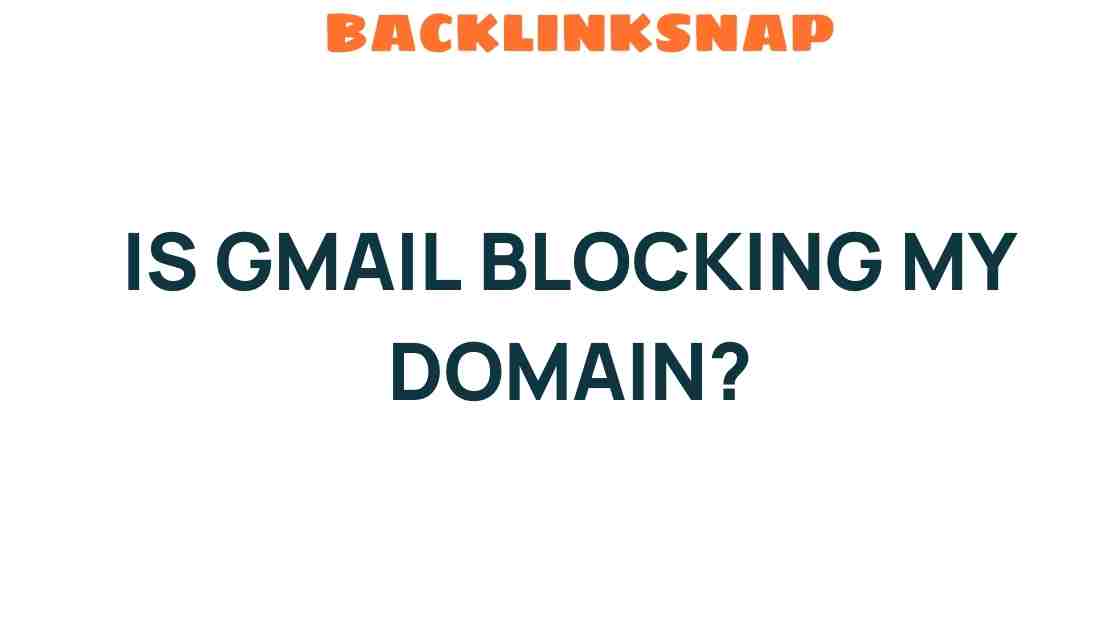Is Gmail Blocking My Domain? Unraveling the Mystery Behind Email Deliverability
In the realm of digital communication, few platforms are as ubiquitous as Gmail. With over 1.5 billion active users, the service is a staple for both personal and business emails. However, if you’ve ever sent an email only to find it languishing in a recipient’s spam folder, you might wonder: “Is Gmail blocking my domain?” Understanding email deliverability is crucial for anyone using email marketing or business communication. This article will explore the various aspects of email deliverability, including domain blocking, spam filters, sender reputation, and more.
Understanding Email Deliverability
Email deliverability refers to the ability of an email message to reach the recipient’s inbox. It’s not just about whether an email was sent; it’s about whether it was successfully delivered and opened. Factors affecting email deliverability include:
- Sender Reputation: This reflects how trustworthy an email sender is, based on various metrics including complaint rates and engagement levels.
- Domain Authentication: Techniques like SPF, DKIM, and DMARC help verify that the email is from a legitimate source.
- Spam Filters: These are algorithms that determine whether an email is suspicious or unwanted.
When Gmail’s spam filters detect something amiss, they may block emails from certain domains. This can significantly hinder your email marketing efforts.
Why Would Gmail Block Your Domain?
Gmail’s sophisticated spam filters are designed to protect users from unwanted emails, but they can sometimes be overly aggressive. Here are some common reasons why Gmail might block your domain:
- Poor Sender Reputation: If your domain has been flagged for sending spam or if your emails have low engagement rates, Gmail may reduce your deliverability.
- Lack of Domain Authentication: Failing to set up SPF, DKIM, and DMARC can lead Gmail to view your emails as suspicious.
- High Bounce Rates: If a significant number of your emails bounce back, Gmail may interpret this as a sign that you’re sending to invalid addresses.
- Content Issues: Emails with spammy content or certain keywords can trigger Gmail’s spam filters.
To improve your email deliverability, you need to be proactive about your sending practices and maintain a good sender reputation.
How to Check if Gmail is Blocking Your Domain
If you suspect that Gmail is blocking your domain, there are several steps you can take to investigate:
- Use Email Testing Tools: Services like Mail Tester or GlockApps can help you analyze your emails and determine if they are likely to be flagged as spam.
- Review Bounce Reports: If you’re using an email service provider (ESP), they often provide bounce reports that can give insight into whether Gmail is blocking your emails.
- Monitor Sender Reputation: Various tools can help you check your sender reputation, such as Sender Score.
- Consult Blacklist Checkers: Use services like MXToolbox to see if your domain is listed on any blacklists.
Improving Email Deliverability
Once you’ve identified potential issues, it’s time to take action. Here are some effective strategies for improving your email deliverability:
- Authenticate Your Domain: Implement SPF, DKIM, and DMARC records in your domain’s DNS settings to help Gmail verify your emails.
- Maintain a Clean Email List: Regularly remove inactive or invalid email addresses to reduce bounce rates.
- Optimize Your Content: Avoid spammy keywords, and ensure your emails provide value to the recipient.
- Engage Your Audience: Encourage recipients to add you to their contact list and interact with your emails to boost engagement rates.
By following these best practices, you can enhance your sender reputation and improve your chances of landing in the inbox rather than the spam folder.
FAQs About Gmail and Email Deliverability
- What is sender reputation?
Sender reputation is a score that reflects how trustworthy an email sender is, based on their sending history and engagement metrics. - How can I authenticate my domain?
To authenticate your domain, set up SPF, DKIM, and DMARC records through your domain host. - What tools can I use to check my email deliverability?
Tools like Mail Tester, GlockApps, and Sender Score can help you assess your email deliverability. - Why are my emails landing in spam?
Your emails may land in spam due to poor sender reputation, lack of authentication, or content issues. - How often should I clean my email list?
It’s advisable to clean your email list at least every six months to ensure high deliverability. - Can I recover a blocked domain?
Yes, by improving your sending practices and addressing the issues that led to the block, you can recover your domain’s reputation.
Conclusion
In conclusion, if you’re wondering whether Gmail is blocking your domain, the answer may lie in your email practices. By understanding the intricacies of email deliverability, sender reputation, and domain authentication, you can take actionable steps to improve your email marketing outcomes. Remember, the goal is to foster trust with your audience and ensure your emails reach their intended inboxes. For further insights, you can explore more about email marketing strategies on reputable marketing blogs and check technical resources on email service providers.
This article is in the category Digital Marketing and created by BacklinkSnap Team




